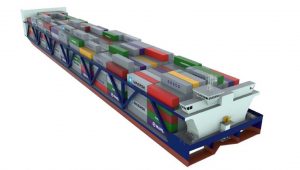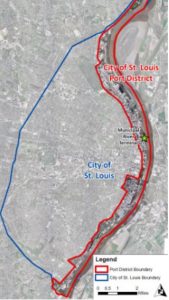Innovative barges may reshape Midwestern river commerce
By Bob Pieper For Chronicle Media — April 11, 2018

Rendering of American Patriot river freight vessel
(Image courtesy of American Patriot Holdings, LLC)
The St. Louis area just took “an important step” in the development of a planned new “hub and spoke” inland freight system serving much of American Midwest, according to the six local entities partnering in the project.
Under plans outlined at a March 27 press conference, an innovative new breed of inland freight vessels will ply the Mississippi River between the Gulf of Mexico and two ports upriver – Memphis and St. Louis – bringing imported goods for distribution throughout Mid-America, as well as transporting Midwestern commodities for export overseas.
Delaware-based American Patriot Holdings, LLC, — established in 2014 specifically to conduct a new type of high-volume shipping along growing, transoceanic freight routes as well as the planned American Marine Highway system in the U.S. — is developing the proprietary, new inland freight vessels and has secured rights to serve a new international freight port under development in New Orleans.
From the planned new Plaquemines Port Harbor & Terminal District in Louisiana, the shipping line plans to use its new breed of boats to transport freight to and from Memphis every six days and St. Louis every 10 days.
There, multimodal containers are to be transferred to railroads cars and over-the-road trucks for distribution throughout the American heartland, while Midwestern mining and agricultural commodities are loaded onto the river crafts for export outside the U.S.
Designed around a patented exoskeleton that allow multimodal freight containers to be stacked one-on-another, the new self-powered rivercrafts will accommodate far bigger loads of than even large, conventional barge trains, according to American Patriot spokespersons.
Some 592 ft. to 952 ft. in overall length, with a beam of 100 ft., the new vessels will be far larger than any conventional barge but far smaller than most large trains on the river. They will transport freight more cost effectively than conventional barges, faster (up to 13 m.p.h. versus 5 m.p.h. for conventional barges), and with smaller wakes to erode riverbanks and infrastructure.
Freezer and refrigerated containers will used to transport perishable produce.

Map of the region of the Port of Metropolitan St Louis and the Port Authority district. (Courtesy of St. Louis Port Authority)
In addition to the new crafts that will traverse the lower half of the Mississippi River, American Patriot plans a fleet of small “hybrid” vessels that will transport freight up smaller rivers, such as the Illinois, Missouri and Red River, as well as through the locks and dams on the Upper Mississippi.
In addition to reviving Plaquemines Parish, an area hard hit by Hurricane Katrina, the new inland shipping plans could be a godsend for St. Louis and Memphis, two of the Midwest’s most economically downtrodden metropolitan areas.
Freight traffic through the St. Louis area is expected to increase 40 percent through the year 2030, proponents of the new freighter system said during last month’s announcement.
Most imported freight reaching the Midwest presently comes by way of the West Coast. However, a prolonged West Coast-wide dockworker strike, involving some 14,000 workers in 2014, has made development of an inland port alternative a shipping industry priority.
The Port of Chicago, which is the world’s largest rail hub as well as the nation’s largest inland port, is essentially locked-in and effectively unable to expand in line with anticipated increases in freight volume.
A Chicago Area Transportation Study calls for the addition of more port acreage than the city has available.
The St. Louis area, — the northernmost, year-around-ice-free spot on the Mississippi, with river traffic unimpeded by locks-and-dams — was a natural choice for the northern terminus of the new freight service, American Patriot spokesperson say.
However, some area business leaders were surprised last month when the freight line announced its northern terminal would be the Jefferson County Port District in Herculaneum, Mo.; about 15 miles downstream of Downtown St. Louis.
American Patriot officials say that, at high river levels, the new vessels may not be able to clear the numerous bridges in the St. Louis metropolitan area; making Herculaneum their only choice.
Accommodating the new freight service will require a $100 million expansion of the Jefferson County port facility and adjacent Riverview Commerce Park; increasing them to as much as 10 times their current 18-acre size.
Funding for the expansion has not yet been arranged. It will probably require a public-private partnership involving companies that operate port facilities, Neal Breitweiser, executive director of the Jefferson County Port Authority, told reporters.

In addition to the new crafts that will travel the lower half of the Mississippi River, American Patriot plans a fleet of smaller vessels to move freight up smaller rivers, such as the Illinois, Missouri and Red River, as well as through the locks and dams on the Upper Mississippi. (Photo courtesy of St. Louis Port Authority)
The City of St. Louis recently spent $19.7 million on updating its Municipal River Terminal just north of the Gateway Arch.
Upstream at Granite City, the America’s Central Port district has spent millions constructing a new South Port to accommodate large-scale river freight lines such as American Patriot.
Nevertheless, Mary Lamie, executive director of St. Louis Regional Freightway program, believes the planned Gulf Coast to St. Louis river freight line will ultimately benefit all St. Louis area port facilities.
Lamie, as well as America’s Central Port Executive Director Dennis Wilmsmeyer and Port Authority of St. Louis Director Susan Taylor, signed onto a memorandum of understanding that will allow entities at both ends of the new Mississippi River fright route to cooperate on data sharing and marketing for the new freight service.
Also signing the agreement: John Nations, president and chief executive officer of Bi-State Development; Sandy Sanders, executive director of Plaquemines Port Harbor & Terminal District; Ed Weilbacher, general manager of Kaskaskia Regional Port District; Neal Breitweiser, executive director of Jefferson County Port Authority; Ken Waller, Jefferson County executive; and Derrick Good, president of Jefferson County Port Authority.
—- Innovative barges may reshape Midwestern river commerce —-



